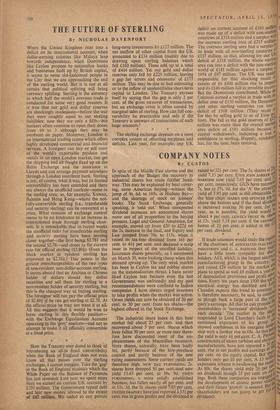COMPAN Y NOTES
By CU
STOS
IN spite of the Middle East alarms and the approach of the Budget the recovery in industrial shares has made further head- way. This may be explained by bear cover- ing, some American buying-witness the jump of 9s. 6d. to 195s. in Hudson Bay- and the shortage of stock on jobbers' books. The Stock Exchange, generally speaking, is 'sold out.' When unexpected dividend increases are announced shares move out of all proportion to the buying pressure. Legal and General Assurance, for example, moved up from £20 to £224 on the 2s. increase in the final, and Equity and Law jumped from 70s. to 115s. when it raised its tax-free dividend from 161 per cent. to 41+ per cent. and declared a scrip issue in respect of the uncalled liability. Insurance shares generally, as I mentioned on March 30, were looking cheap when this demand sprang up. The only weak market has been in Ceylon tea and rubber shares on the nationalisation threat. I have never liked Ceylon teas because even the last Government was unfriendly and my past recommendations were confined to Indian companies. I have always urged investors to take profits when the market was active. Gross yields can now be obtained of 20 per cent. to 30 per cent., from tea shares-the highest offered in the Stock Exchange.
The industrial share index in. this bear market fell about 25 per cent. and then recovered about 5 per cent. Shares which have fallen 30 per cent. or more may there- fore have discounted most of the un- pleasantness of the Macmillan recession. Store shares, naturally, have been badly hit, partly because of the hire-purchase control and partly because of the new rating assessments. Some current yields are therefore high. NEW DAY FURNISHING 2s. shares have dropped 50 per cent..and now yield 13.45 per cent, at 10s. 9d. TIMES FURNISHING, a more solidly established business, has fallen nearly 40 per cent. and at 12s. 3d. the 5s. shares yield 7.85 per cent. UNITED DRAPERY have just reported a 334 per cent. rise in gross profits and the dividend is tions.Every ten years since 1900 the used 1, electrical energy has doubled and 1)311 '4: Chandos expects this trend to continue..i. in is therefore necessary, he said, to COntina'it, LI( to plough back a large part of the, cony pany's earnings. All that he can promise shareholders is `increased' dividends `0s,..; each decade.' The market in the SI/34'hvel responded to Lord Chandos's faith in 'n'J continued expansion of his group showed confidence in his energetic le3‘'7epi ship with a further rise to 68s. At this Prin-51 de the yield is only 44 percent. C. A. PatS°;$11 at constructors of steam turbines and elecieQ manufacturers, have just reported a 39 roe; te,,, cent. rise in net profits and earnings 01 '4.1 per cent. on the equity capital. But slin,'01 holders only get‘ 10 per cent. A £3 roillio,; expansion scheme is,swallowing tc4: At 80s. the shares yield only 24 per c".."0. 'fie on dividends though 25 per cent. on e3,' 0,141 ings. Both these companies are. engagestit the development of atomic power stn1.1"tieil and their future 'growth' is assured. 13u; :010 i" shareholders are not going to get fatty dividends. raised to 324 per cent. The 5s. shares at P yield 7.35 per cent. Even JOHN BARKER 1.2 HARRODS !IOW yield 7.65 per cent. and di per cent. respectively. GUS have recover 7s. but at 37s. 9d. for the 'A' the attrantin`f yield of 7.95 per cent. is still obtainable. the 'blue chips' MARKS AND SPENCER are 65a above the bottom and if the final divider!, is increased making 50 per cent. for in year, as is possible, the yield would v" about 4 per cent. LEWIS'S TRUST 4s. she , at 12s. yield 5.35 per cent. if the centeear.1 bonus of 24 per cent. is added to the I3 per cent. dividend.
If trade unionists would study the repoto of the chairmen of ASSOCIATED ELECTRni INDUSTRIES and C. A. PARSONS they Ogre have a little more sympathy for O! holders. AEI, which is the largest electrto manufacturing group in the country, L'od just raised £24 million in the market fl„tii plans to spend as well £8 million a year on, of depreciation provisions and profit rewoi










































 Previous page
Previous page